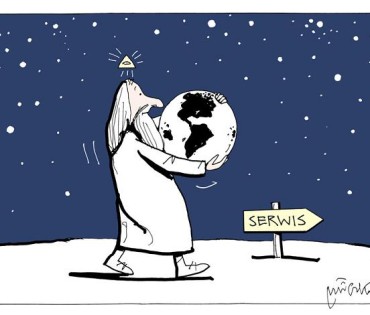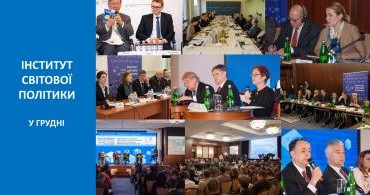The Day NewspaperAn international political cartoon exhibition opened the other day on Kyiv’s Kontraktova Square. The project was conceived by the Slovakia-based international organization Euforion. At first the exhibition consisted of the works of two Slovak cartoonists and was mounted in Slovakia alone. Then it moved to the Czech Republic, Poland, Hungary, and Georgia. In each country, the organizers tried to choose the local masters’ best works which could be of interest to global audiences.
“We received the idea of holding this exhibit from Euforion, a Slovak nongovernmental organization,” says Serhii Solodky, an exhibit co-organizer, first deputy director of the Institute of World Politics. “They came to know about our 2013 on-the-street cartoon exhibition about Ukraine’s integration into Europe. It received wide coverage in the Czech, Macedonian, and Polish media. So, the Slovaks invited us to take part in a political cartoon exhibit that would focus on some more urgent challenges the entire world is facing. One of our institute’s missions is to put these issues across to the public at large. This is why we agreed to cooperate. While the previous exhibit was aimed at encouraging the Ukrainian people to control the authorities, this one has far wider horizons. It urges all people on the globe to be more responsible and exposes the existing faults in international relations. The drawings show us a weak Barack Obama who does not want to intervene in anything and make any decisions, Russia’s aggression against Ukraine, and a discord inside the European Union.”
The Ukrainian school of political cartoon did not disappoint our Western colleagues. They noted that our masters’ works were of quite a high quality and could be of interest not only to domestic audiences, but also to people all over the world. But what often hinders the development of caricature in the mass media is… the media themselves in spite of the fact that this genre makes publications popular among the public at large. According to Euforion head Tomas Lukacka, this is a specific Ukrainian phenomenon. “As we can see, cartoons are not very popular in the Ukrainian media, but the situation can change radically. You have superb masters who can arouse the people’s interest in caricature. Past year we visited Georgia, where political caricature is so far in its infancy – it is an altogether new genre for that country. Conversely, the situation in Ukraine is different. You have people who have worked in this genre. But, for caricature to develop further, you should give masters more freedom of work. The media should know that cartoons draw more attention of the reader than texts do. Even one sketch can draw the attention of thousands of people, and far from all of them will read the text. Therefore, political caricature must exist,” he says.
Foreign experts have pointed out that the Ukrainian school of caricature shows longtime traditions which have influenced not only the technique of masters, but also the choice of the acute problems to tackle. The newspaper Den has also made its contribution to the development of caricature. For it is here that Anatolii Kazansky, called “the best cartoonist of Ukraine” by his contemporaries, worked from 1996 until the end of his lifetime. The history of the Ukrainian tradition of caricature began with him and the Kyivan club Archhum. But cartoons are gradually degenerating in the Ukrainian media. As cartoonists themselves are saying, only a few publications, including Den, are still interested in this genre and are ready to use it.
“Caricature in Ukraine, as well as throughout the world, is developing as part of the mass media, and the trend of this development has, unfortunately, taken a downward turn. The printed press is being rapidly superseded by the Internet, and online publications’ demands to illustrations (cartoons are almost always used as illustrations to a text) are much more modest than those of printed newspapers and magazines. The publications that use the genre of caricature can also be counted on the fingers of one hand. Obviously, it is a wrong situation because this genre has always been indispensable during wars, revolutions, and social cataclysms,” says Ihor Lukianchenko, a Ukrainian artist and Den contributor. “It is not only a mirror of events, but also a variety of ideological weapons. Den is one of the publications that keep the caricature genre intact. Since its very inception, Den was lucky to have such a cartoonist as Anatolii Kazansky whose illustrations helped the newspaper make its inimitable face and style. After his tragic death, he goes on living in his sketches on Den’s pages, and his cartoons still remain sharp and topical.”
The development of caricature directly depends on the demands of society, says Daryl Cagle, one the best-known US editorial cartoonists. According to his observations, only a few countries attach as much importance to cartoons as can be comparable to the clout they wield.
“I’ve noticed that in America, as well as in Ukraine, cartoons do not influence society as much as in France. In most countries of the world, they occupy a tiny fraction of the media space. And this disappoints me. For me, France is sort of a center of political caricature. It’s wonderful when masters have a feeling of the people they work for. This understanding depends on culture itself, on whether this contribution is valuable for it. I wish cartoonists and their work received more recognition in both the US and Ukraine,” he said.
In Cagle’s words, what also shows a considerable emotional impact of cartoons is the fact that cartoonists are much more often exposed to danger today than the other media people. “It is dangerous now to be a cartoonist all over the world due to the threat of terrorism. Well before the Charlie Hebdo story, our website was attacked much more often than a few years before. It is expensive and difficult to tackle this kind of problems. It is a new world for us. Everybody is now in danger. We cannot provide ourselves with personal guards, so we have to put up with all threats as part of our professions. Incidentally, unlike my French colleagues, I’ve never come across these problems in America. My country is not so much diversified culturally, so our cartoons usually focus on other problems, such as, for example, drug abuse. This really preoccupies the populace now. But I express my ideas in a more restrained way in my cartoons because our readers are more reserved in their emotions. Besides, religion is a very painful subject for them.”
In spite of old traditions, caricature in Ukraine is gradually declining. Some repudiate it because of a high price, others for fear of being misunderstood by the audience. But the current events in this country are opening a wide field for creative work and experiments in this genre. We can only hope that these tendencies will attract both the artists and those who can put these works across to mass-scale audiences.
By Olena BEREZHNIUK, The Day




Comments theme
Comments themeComments themeComments themeComments themeComments themeComments themeComments themeComments themeComments themeComments themeComments themeComments themeComments themeComments themeComments themeComments themeComments themeComments themeComments themeComments.